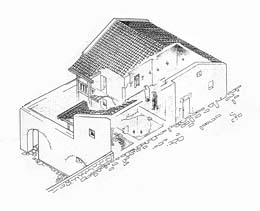Like Grandfather, Like Granddaughter: Oldest Synagogue in Jerusalem Identified, Judith Sudilovsky, BAR 25:03, May-Jun 1999.
 Following in her late grandfather’s footsteps, Hebrew University archaeologist Eilat Mazar has identified the oldest synagogue in Jerusalem—a room in a structure dubbed “the House of Menoroth” (House of Menorahs, or Candelabra). The building was discovered by Benjamin Mazar, who in 1967 began excavations at the southwestern corner of the Temple Mount, an area now set aside as an archaeological park.
Following in her late grandfather’s footsteps, Hebrew University archaeologist Eilat Mazar has identified the oldest synagogue in Jerusalem—a room in a structure dubbed “the House of Menoroth” (House of Menorahs, or Candelabra). The building was discovered by Benjamin Mazar, who in 1967 began excavations at the southwestern corner of the Temple Mount, an area now set aside as an archaeological park.
An engraved cross on the building’s lintel led scholars to conclude that it was originally a Christian public building from the Byzantine period. According to the younger Mazar, however, the paintings of seven-branched menorahs that cover the walls of one room suggest that the building was later reused for Jewish worship. The ubiquity of glass lamps, as well as indentations in the doorjambs likely used for mezzuzot (doorpost fixtures containing small Hebrew scrolls), leaves little doubt in her mind that the structure was briefly used as a Jewish public building during the period of Persian rule in the first part of the seventh century. (The second-earliest known synagogue in Jerusalem dates from the twelfth century.)
“Menoroth in a room like this can only mean a synagogue,” Mazar said. “People did not decorate their homes with so many menoroth, and you would never see such decorations in a classroom.”
A niche in the southern wall of the room may have held the Torah scroll, which worshipers faced during prayer, according to Mazar. Positioning the Torah niche in the southern wall would, however, have been contrary to the Jewish tradition of praying towards Jerusalem and the Temple Mount. Mazar offers two reasons for the southern placement- First, the door of the room faces the Temple Mount. If people prayed in that direction, they would have appeared to have been praying to whoever entered the room. Second, the room was in use when the Al Aqsa Mosque was being built. If worshipers faced the Temple Mount, it would have seemed that they were praying to the mosque.
To buttress her argument, Mazar also points to a document discovered in the Cairo Genizah (the repository for worn-out scrolls in Cairo’s medieval synagogue), which indicates that Caliph Omar ibn Alhatab (634–644) granted permission to 70 Jewish families from Tiberias to settle in Jerusalem following the Muslim conquest of the city. The families naturally would have sought out a place to pray. This building, says Mazar, would probably have fit the bill. It was “not a very fancy synagogue. It was a very simple place and typical of poor families.”
Although this is the earliest synagogue room found in Jerusalem, there is archaeological evidence of at least one earlier synagogue. A dedicatory inscription found in Jerusalem mentions one Theodotus, who “built this synagogue for the reading of the Laws and for the teaching of the Commandments.” Discovered by French archaeologist Raymond Weill in 1913 in a Jerusalem cistern, the inscription dates to the Herodian period (37 B.C.–70 A.D.).



